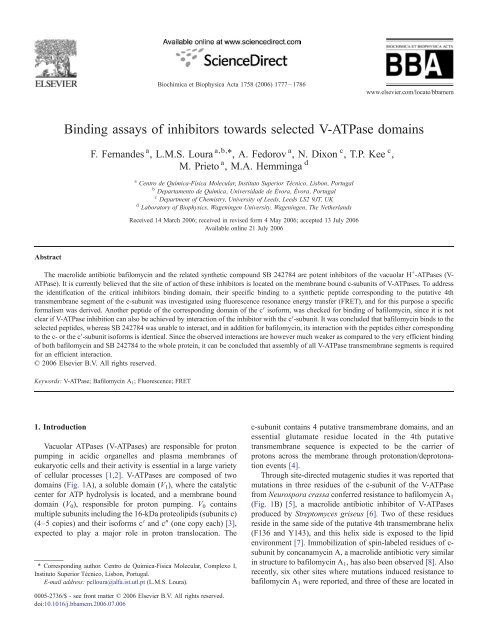Biophysical studies of membrane proteins/peptides. Interaction with ...
Biophysical studies of membrane proteins/peptides. Interaction with ...
Biophysical studies of membrane proteins/peptides. Interaction with ...
Create successful ePaper yourself
Turn your PDF publications into a flip-book with our unique Google optimized e-Paper software.
Biochimica et Biophysica Acta 1758 (2006) 1777–1786<br />
www.elsevier.com/locate/bbamem<br />
Binding assays <strong>of</strong> inhibitors towards selected V-ATPase domains<br />
F. Fernandes a , L.M.S. Loura a,b, ⁎ , A. Fedorov a , N. Dixon c , T.P. Kee c ,<br />
M. Prieto a , M.A. Hemminga d<br />
a Centro de Química-Física Molecular, Instituto Superior Técnico, Lisbon, Portugal<br />
b Departamento de Química, Universidade de Évora, Évora, Portugal<br />
c Department <strong>of</strong> Chemistry, University <strong>of</strong> Leeds, Leeds LS2 9JT, UK<br />
d Laboratory <strong>of</strong> Biophysics, Wageningen University, Wageningen, The Netherlands<br />
Received 14 March 2006; received in revised form 4 May 2006; accepted 13 July 2006<br />
Available online 21 July 2006<br />
Abstract<br />
The macrolide antibiotic bafilomycin and the related synthetic compound SB 242784 are potent inhibitors <strong>of</strong> the vacuolar H + -ATPases (V-<br />
ATPase). It is currently believed that the site <strong>of</strong> action <strong>of</strong> these inhibitors is located on the <strong>membrane</strong> bound c-subunits <strong>of</strong> V-ATPases. To address<br />
the identification <strong>of</strong> the critical inhibitors binding domain, their specific binding to a synthetic peptide corresponding to the putative 4th<br />
trans<strong>membrane</strong> segment <strong>of</strong> the c-subunit was investigated using fluorescence resonance energy transfer (FRET), and for this purpose a specific<br />
formalism was derived. Another peptide <strong>of</strong> the corresponding domain <strong>of</strong> the c′ is<strong>of</strong>orm, was checked for binding <strong>of</strong> bafilomycin, since it is not<br />
clear if V-ATPase inhibition can also be achieved by interaction <strong>of</strong> the inhibitor <strong>with</strong> the c′-subunit. It was concluded that bafilomycin binds to the<br />
selected <strong>peptides</strong>, whereas SB 242784 was unable to interact, and in addition for bafilomycin, its interaction <strong>with</strong> the <strong>peptides</strong> either corresponding<br />
to the c- or the c′-subunit is<strong>of</strong>orms is identical. Since the observed interactions are however much weaker as compared to the very efficient binding<br />
<strong>of</strong> both bafilomycin and SB 242784 to the whole protein, it can be concluded that assembly <strong>of</strong> all V-ATPase trans<strong>membrane</strong> segments is required<br />
for an efficient interaction.<br />
© 2006 Elsevier B.V. All rights reserved.<br />
Keywords: V-ATPase; Bafilomycin A 1 ; Fluorescence; FRET<br />
1. Introduction<br />
Vacuolar ATPases (V-ATPases) are responsible for proton<br />
pumping in acidic organelles and plasma <strong>membrane</strong>s <strong>of</strong><br />
eukaryotic cells and their activity is essential in a large variety<br />
<strong>of</strong> cellular processes [1,2]. V-ATPases are composed <strong>of</strong> two<br />
domains (Fig. 1A), a soluble domain (V 1 ), where the catalytic<br />
center for ATP hydrolysis is located, and a <strong>membrane</strong> bound<br />
domain (V 0 ), responsible for proton pumping. V 0 contains<br />
multiple subunits including the 16-kDa proteolipids (subunits c)<br />
(4–5 copies) and their is<strong>of</strong>orms c′ and c″ (one copy each) [3],<br />
expected to play a major role in proton translocation. The<br />
⁎ Corresponding author. Centro de Química-Física Molecular, Complexo I,<br />
Instituto Superior Técnico, Lisbon, Portugal.<br />
E-mail address: pclloura@alfa.ist.utl.pt (L.M.S. Loura).<br />
c-subunit contains 4 putative trans<strong>membrane</strong> domains, and an<br />
essential glutamate residue located in the 4th putative<br />
trans<strong>membrane</strong> sequence is expected to be the carrier <strong>of</strong><br />
protons across the <strong>membrane</strong> through protonation/deprotonation<br />
events [4].<br />
Through site-directed mutagenic <strong>studies</strong> it was reported that<br />
mutations in three residues <strong>of</strong> the c-subunit <strong>of</strong> the V-ATPase<br />
from Neurospora crassa conferred resistance to bafilomycin A 1<br />
(Fig. 1B) [5], a macrolide antibiotic inhibitor <strong>of</strong> V-ATPases<br />
produced by Streptomyces griseus [6]. Two <strong>of</strong> these residues<br />
reside in the same side <strong>of</strong> the putative 4th trans<strong>membrane</strong> helix<br />
(F136 and Y143), and this helix side is exposed to the lipid<br />
environment [7]. Immobilization <strong>of</strong> spin-labeled residues <strong>of</strong> c-<br />
subunit by concanamycin A, a macrolide antibiotic very similar<br />
in structure to bafilomycin A 1 , has also been observed [8]. Also<br />
recently, six other sites where mutations induced resistance to<br />
bafilomycin A 1 were reported, and three <strong>of</strong> these are located in<br />
0005-2736/$ - see front matter © 2006 Elsevier B.V. All rights reserved.<br />
doi:10.1016/j.bbamem.2006.07.006















